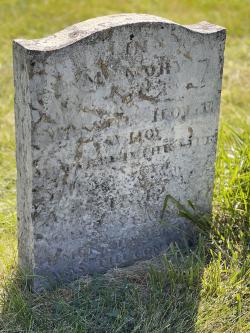Mercy (Massee) Ludlow Hole

Mercy (Massee) Ludlow Hole is buried in the Old Sugarcreek Baptist Church Cemetery in Centerville, Ohio.
Mercy (Massee) Ludlow Hole
By Joellen Ulliman, Curator
Mercy Ludlow Hole, known as Massee, most often is seen simply as the wife of a very important man, Dr. John Hole. The Holes were the first settlers in Washington Township in 1796, and John was the first and only doctor in what is now Montgomery County for five years. However, Massee’s life of sacrifice, hardship, and love tells the story of not only support for her husband, but of quiet strength, resilience, and courage.
Massee began her life on Feb. 28, 1759 in New Jersey. She lived a refined, modestly comfortable life in the early years. She was a cousin of Israel Ludlow, the first surveyor of Cincinnati. Daniel Cooper, surveyor of Dayton, was a distant relative.
Her life quickly changed when she married John Hole on August 14, 1778 at the age of 19. He served earlier in the American Revolution as a physician and surgeon.
The young couple resided in Providence, New Jersey. They lived a cultured life as part of the medical community. They entertained often, reportedly serving George Washington, Thomas Jefferson, and other Patriots hearty meals and lively conversation.
The Holes began their family in Providence. Those nine years were filled with joy and heartache. Jeremiah, their first child, was born in 1779 when Massee was 20. Just 2 years later in 1781, Mary was born. Then 2 years after her birth, William was born in 1783. He died in 1785 at age 2.
Massee, age 27, was baptized on April 16, 1786 at the New Providence Presbyterian Church along with Jeremiah and Mary. Also, in 1786, Elizabeth (Betsy) was born. On July 29,1787, Betsy was baptized into the church.
Sadly, Mary died in 1787 at age 6 years, 16 days. The family experienced a very brief move to Virginia during this same year; they quickly moved back to New Jersey.
A year later, in 1788, twins Jane and James were born. James died the same year.
Only Jeremiah, Betsy, and Jane survived to make the tedious journey to the Northwest Territory with their parents in 1789. John earned warrants in the American Revolution to buy land, and John Symmes, a Continental Congress member who held the Ohio land between the Miami Rivers, was very convincing about the wonderful opportunities awaiting settlers.
The Holes traveled overland in a group that included Israel Ludlow, Daniel Cooper, and both men’s families. Massee was 30 when the party ventured down the Ohio River on a flat bottom boat, meager possessions loaded on a wagon. The boat docked at Limestone, KY, a common location for people moving west to restock and reload supplies. They stayed for several weeks, resting and preparing. Then they moved on.
Finally, the group reached Losantiville, present day Cincinnati. Immediately, the stark reality of pioneer life was evident. Israel was commissioned to take the place of one of three proprietors in the settlement. That proprietor? Missing…no one was certain what exactly happened to him, but rumors claimed his disappearance was due to skirmishes with the Indigenous people who lived there. The relationship between the settlers and these folks was hostile; stories of scalping, rapes, and murders ran rampant through the encampment.
John agreed to build a 1.5 story home and stay at least 2 years minimum in exchange for the rite of ownership. At the time, only 11 families and 24 single men populated Losantiville in crude log cabins.
John realized the value in owning land, so he bought 9 additional lots between 1789-1790; he sold them as more settlers arrived. John was one of the first 78 settlers. He was the only doctor for a while. He was considered “the father of the medical profession” in the new settlement.
The harsh life along the Ohio River was dangerous. There was constant threat of animal and tribal attacks. Massee feared for the safety of her growing family. On August 6, 1791, she gave birth to Daniel; she was 32.
Another vicious threat cast a dark shadow over all of them: smallpox. An outbreak occurred among the settlers in the winter of 1792-93. John knew how to inoculate against the fatal disease from his time in the American Revolution. He prevented a full-fledged epidemic from occurring.
Despite his medical accolades, he and Massee were never fully accepted into the established society. His medical education and methods were different than other doctors’. Much of his training came from crude battlefield experience.
Massee became increasingly sad and withdrawn. Quiet by nature, the changes and horrors she witnessed were terrifying. She gave birth to another girl, Polly Ludlow, in 1794.
John moved them all to protected government land near Lexington, KY around this time.
However, the grey, rainy weather caused Massee to be even more depressed. In 1795, the Holes moved back to the Losantiville area, near Fort Washington. The village grew in their absence to almost 500 settlers living in 54 cabins. A school, jail, and Presbyterian church were being constructed. Massee seemed to not be as afraid, but there were still reports of raids and killing. John scouted to find a safer spot to permanently settle. He traveled north, further into the Symmes’ Purchase, in the spring of 1796. He left 37-year-old Massee with the 5 children. On May 20, Massee had Nancy, their sixth living child.
John found what he deemed the perfect location on Silver Creek in current Washington Township. The area between the Miami Rivers was used as native hunting grounds; animals were plentiful and the land densely wooded. John dreamed of harnessing the water power of Silver Creek. He built a cabin, wintered over, and used land warrants to purchase 1,089.35 acres.
A year later, in 1797, he retrieved his family from Cincinnati. It took 10 days for the group to navigate the exceedingly thick underbrush with the covered wagon. They brought a few home furnishings and cookware, such as a pot and kettle that had been with them since New Jersey, so long ago.
In June of 1798, when Massee was 39, John Ludlow was born. John built a larger log cabin to support his expanding family. He built a springhouse. Other settlers in these parts called the cabin the “mansion house” because of its expansive size.
John needed another income source, for although he practiced medicine, it was not lucrative. He charged 50 cents per house call, and even then, most people paid in produce, animals, and homemade goods.
He built 2 sawmills along the creek; by then, people were rushing into the area. He saw the opportunity for more lumber to be produced and sold. One of those sawmills was run by John Ludlow throughout his adult life.
Two more daughters joined the family. Matilda was born in approximately 1800 when Massee was 41. Phebe was born in approximately 1803 when Massee was 44.
Although life settled into routine, Massee was prone to worry and always on alert for possible attacks from the Indigenous people with whom she came in contact. Once, a hunting party of 3 knocked on the cabin door; Massee was visibly nervous until John arrived and communicated with them. They were invited in for a meal. On their return trip, they stopped at the mansion house and gave the Holes fresh venison in appreciation for their kind hospitality.
Actually, the local Indigenous people respected John as a physician, calling him the “white medicine man on Hole’s Creek” as Silver Creek began to be called. The Holes welcomed everyone into their home for a meal, overnight lodging, and companionship. This included settlers, travelers, Indigenous people.
In 1811, son Jeremiah died at age 32. His death was a truly difficult loss for both Massee and John. Daughter Polly Ludlow, only 17, died that year as well.
John was asked to serve in the War of 1812, but his constitution was weakened. Exposure to cruel weather during his time in the Revolution at the Battle of Quebec caught up with him. Many times, he rode his horse for days on house calls, sleeping outside in miserable conditions. Additionally, he suffered from jaundice for 20 years.
On January 6, 1813, John died at age 54. As per custom, Massee sold off almost 400 acres to pay for accumulated debt. She sold 61 of those acres to William Luce and Thomas Clawson, men slated to find investors to build a water-powered textile mill on Hole’s Creek. That textile mill was the beginning of Woodbourne, a booming industrial town until the mid-1800’s or so, located in the northwest part of Washington Township. A few years before his early death, John envisioned and platted out a town along the creek. His vision finally came to fruition soon after he died.
Massee lived the rest of her life in the mansion house with daughter Phebe, who never married. Nancy and David passed before Massee did at age 83 years, 4 months, 26 days on July 25, 1842.
John was credited with being the first doctor in Cincinnati, first Washington Township settler, first/only doctor in Montgomery Co. for 5 years, and one of the first 120 doctors named to the Ohio Medical Society in 1812. However, it was his beloved wife Massee who offered quiet, supportive inspiration that led him to their shared destiny.
researched and compiled by Joellen Ulliman, CWH Curator August 2023